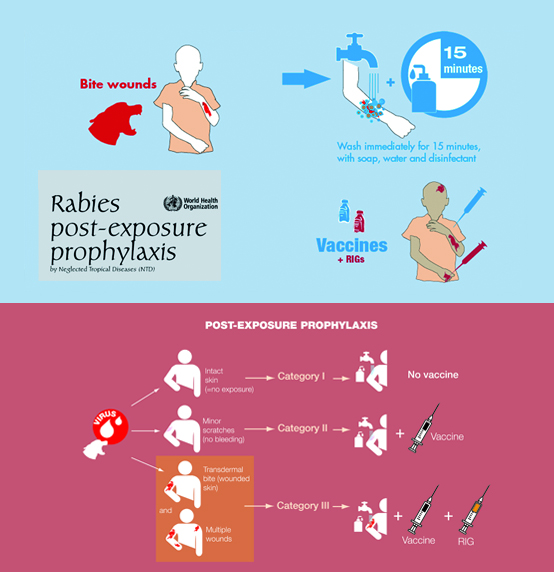Rabies postexposure prophylaxis (PEP) is an urgent, life-saving intervention administered to individuals exposed to the rabies virus. Given the nearly 100% fatality rate of symptomatic rabies, timely and correct PEP administration is critical. Our detailed guide outlines the best practices in evaluation, wound management, vaccination, and immunoglobulin use following a potential exposure.

Understanding Rabies Virus and Risk of Exposure
Rabies is caused by lyssaviruses, primarily transmitted to humans through the saliva of infected animals via bites, scratches, or mucous membrane exposures. Domestic dogs account for the majority of human rabies deaths worldwide, whereas in developed countries, wild animals such as bats, raccoons, skunks, and foxes are more common sources.
Initial Evaluation Following Suspected Rabies Exposure
Stepwise Risk Assessment
- Animal species involved: Higher risk with bats, raccoons, skunks, foxes, unvaccinated dogs and cats.
- Circumstances of exposure: Provoked vs. unprovoked attacks.
- Geographic location: Local rabies prevalence rates guide urgency.
- Animal behavior and health status: Abnormal behavior increases suspicion.
Immediate Wound Management: First Line of Defense
- Thorough cleansing with soap and copious amounts of water for at least 15 minutes.
- Irrigation with virucidal agents such as povidone-iodine if available.
- Debridement of devitalized tissue if necessary.
- Avoidance of wound suturing unless absolutely necessary; if required, suturing should follow rabies immunoglobulin (RIG) infiltration.
Prompt wound care can significantly reduce the risk of rabies transmission.
Components of Rabies Postexposure Prophylaxis
PEP consists of two critical elements:
- Rabies Vaccination
- Rabies Immune Globulin (RIG)
Rabies Vaccination Protocols
For Previously Unvaccinated Individuals
- Day 0 (first dose): Administer vaccine immediately after exposure is identified.
- Subsequent doses: Given on Days 3, 7, and 14.
- Immunocompromised patients: An additional fifth dose on Day 28 is recommended.
For Previously Vaccinated Individuals
- Only two doses are required:
- Day 0 and Day 3
- No RIG administration necessary for previously vaccinated individuals.
Vaccine Administration
- Administer intramuscularly (IM) in the deltoid area for adults and older children.
- Anterolateral thigh is preferred for infants and young children.
- Avoid gluteal administration due to decreased immunogenicity.
Rabies Immune Globulin (RIG) Administration
Indications
- Essential for individuals not previously vaccinated against rabies.
- Administer as soon as possible, preferably at the time of the first vaccine dose.
Dosage
- 20 IU/kg body weight for human rabies immunoglobulin (HRIG).
Method
- Infiltrate as much of the dose as anatomically feasible directly into and around the wound.
- Remaining volume, if any, should be injected intramuscularly at a site distant from vaccine administration.
Special Considerations in Rabies PEP
Delayed Presentation
PEP remains indicated regardless of delay after exposure if clinical rabies has not developed.
Pregnant and Breastfeeding Women
Rabies PEP is safe and should not be withheld.
Immunocompromised Patients
An adjusted vaccination regimen with serologic testing post-vaccination is recommended to confirm adequate immune response.
Monitoring and Follow-Up
- Observe the animal when feasible for 10 days (for domestic dogs, cats, and ferrets).
- Immediate discontinuation of PEP if the animal remains healthy through observation or tests negative via laboratory methods.
Common Side Effects of Rabies PEP
- Local reactions at the injection site (pain, redness, swelling)
- Mild systemic symptoms (fever, headache, dizziness)
- Serious adverse events are extremely rare.
Strategies to Improve Access and Compliance
- Availability of prepackaged PEP kits.
- Public education on rabies risks.
- Streamlined hospital protocols for rapid administration.
Frequently Asked Questions
Can rabies PEP be started if the animal is unavailable for observation?
Yes, PEP should not be delayed if the biting animal cannot be observed or tested.
Is rabies PEP effective after symptoms begin?
No. Once clinical symptoms of rabies appear, PEP is ineffective and fatality is almost certain.
Can PEP be administered at any healthcare facility?
Yes, however, providers must ensure the correct vaccine type and immunoglobulin are available.
Are there any contraindications to rabies PEP?
There are no contraindications; rabies exposure necessitates PEP regardless of individual circumstances.
How long does protection from PEP last?
PEP confers protection from the specific exposure event but does not provide lifelong immunity unless preexposure prophylaxis is completed later.